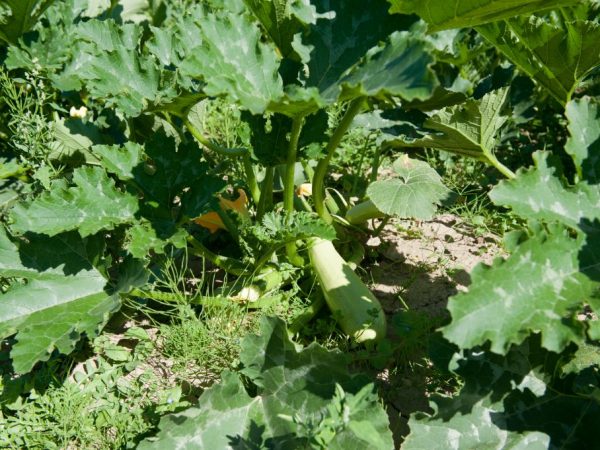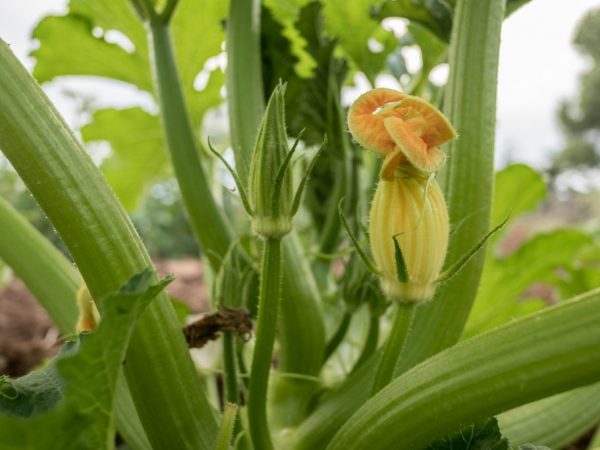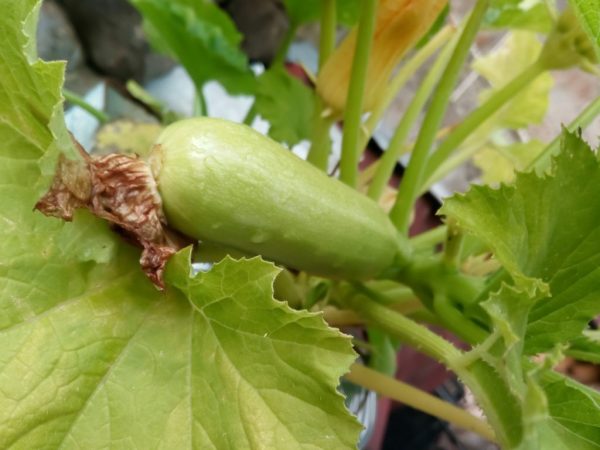Varietal features of zucchini Gribovsky 37
Gribovsky zucchini is the most famous variety among gardeners. It has a light color and brings high yields in almost all regions of the country. A versatile vegetable, convenient for preparing a variety of dishes and preserving.

Varietal features of zucchini Gribovsky 37
Description
Gribovsky white-fruited belongs to the mid-early varieties. The vegetable is elongated and 20 centimeters long. Matures in 45 days. The finished fruit weighs about a kilogram.
Zucchini is white with a smooth skin. The mature fruit turns green. If it is overripe, it turns yellow. Inside, the pulp is compacted and snow-white. Stems are even, slightly ribbed. It grows as a bush, leaves are large pentagonal, petioles are long. The flowers are yellow.
The yield reaches 5-10 kg per square meter.
The variety has a high yield and is resistant to diseases. The only drawback is the rapid ripening, which further leads to the overripe condition of the fruit.
Seedling
Before planting, the seeds are soaked in a specially prepared solution. Its composition:
- 1 liter of water;
- 1 tsp nitrophosphate.
Leave the seeds in this solution for 3 days. Before planting, the soil is preliminarily loosened and the seeds are lowered there by 4 centimeters.
To get an early harvest, the seedlings are first placed in containers on the windowsills, starting in April. They are planted in open soil after May 10 and until June 10. It is necessary to cover it with foil when planting in early spring.
Outdoor cultivation
To transplant zucchini into open ground, you must wait until three leaves appear. Seedlings are taken out into the street in stages. First, by 1.5 hours, on the second and subsequent days, the hardening is increased by two hours.
The planting area for the Gribovsky 37 zucchini is 70 by 70 cm.Pull the seedlings out of the pots carefully so as not to damage the root system. The plant is buried in, leaving the leaves above the ground. The location in the ground should be illuminated by the sun only in the first half of the day.
The variety tolerates a relatively low temperature of 7 ° C.
Growing in a greenhouse

Plants need to be fed
The soil should have a slightly alkaline environment, preferably neutral. Additionally, the soil is enriched with compost, mineral complexes and fertilizers are applied. Superphosphate is suitable for these purposes. Chlorine fertilizers should not be added to the soil.
Plant care scheme in a greenhouse:
- removal of weed crops;
- feeding once every two weeks;
- watering;
- loosening.
Squash seedlings are transplanted into a greenhouse 20 days after germination. Leave gaps between plants up to 75 cm. Zucchini are transferred to greenhouses from under the film from the end of April. Before that, the soil is heated with stoves or electrical appliances.
Mulching
The moisture level affects the yield of the crop. The soil is covered with foil, leaving holes for the zucchini. Plants are watered into these holes. Sometimes mulching is carried out with sunflower meal and sawdust. This gives warmth to the vegetable.
At the same time, overheating has a negative effect on squash.The daytime temperature for normal growth and development is 23 ° C and 17 ° C at night. The humidity in the greenhouse should be 65%. The heat leads to the dropping of the ovaries, and the lowering of the temperature - to the cessation of the growth of zucchini.
Care
Shrub zucchini varieties Gribovsky 37 are watered once a week. If the water is hard, it is softened. The liquid temperature should be 20-23 ° C. The greenhouse is ventilated every day so that pollination occurs. Fresh air leads to a rapid ripening of the variety.
For better pollination by insects, a cotton solution of sugar is applied to the plants. In the fall, they bring in manure, ash to normalize acidity, a little sand and sawdust. Dense earth is not suitable for planting, so it is dug up.
If the plant has been in the greenhouse since May, then the film is kept closed until the shoots reach 25 cm.
Harvesting and storage
Fruit ripening is completed in 1 month. Vegetables are harvested when the length is 25 cm. Such fruits are the most delicious and nutritious. The main thing is not to overexpose the zucchini in the garden, otherwise it quickly coarsens.
Overgrown zucchini are great for ripening and harvesting seeds. The Gribovsky variety is stored at a temperature of 4 to 10 ° C heat and air humidity 85%. In such conditions, he will lie in the cellars until the beginning of spring.
For the winter, they keep it in the form of various pickles and marinades. Zucchini are good frozen. The taste of such a product does not differ from the fresh appearance.
Diseases and pests

Spraying will help control pests
Like any other vegetable, it is threatened by certain diseases and pests.
Spider mite
Tick infestations are more common in greenhouses. It is also found outdoors. The insect clings under the leaf and weaves its webs. This is a sure sign of illness. The leaves gradually begin to dry out, and the plant may die if you do not fight the spider mite.
To get rid of the infection, grind the onion. One glass of onion mixture is diluted in a bucket of water, 1 spoonful of pepper, 3 tablespoons of ash and soap solution are added. Bushes are sprayed with this agent. The procedure is repeated twice at intervals of six days.
Melon aphid
This insect is green, round in shape. Its length is only 2 mm. Their larvae have yellowish wings. They come to the Gribovskie zucchini from the weeds. They are located in the lower part of the leaf and on the stems. Aphid infestation leads to drying and twisting of the plant, the ovaries disappear.
To prevent the melon aphid from settling on zucchini, weeds are removed. Spraying with karbofos is carried out. Dilute 60 g of the substance in 10 liters of water. If an infection has occurred in the greenhouse, then it is poured with a solution of triphos in a ratio of 1 to 100.
Sprout fly
Fly up to 10 mm long, gray with a distinctive stripe on the abdomen. She lays white larvae. The eggs are in the ground and after 10 days they destroy the seeds of squash crops, as well as young shoots.
To control the fly, weeds are destroyed. In late spring, seeds are planted at a medium depth.
Reviews of gardeners
Among the variety of zucchini varieties, Gribovsky 37 is very popular among both amateur gardeners and professionals. According to reviews, this type of culture is easy to care for, resistant to various diseases and unpretentious. It is easy to care for it, it is distinguished by high germination of seeds.
This zucchini shows itself on a pleasant side to many gardeners. It has a suitable presentation. Well tolerates long-distance transportation. The plant is high-yielding.

